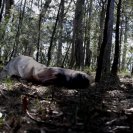Efface: Death Becomes Her is a video and performance that examines eternal grief as a continuum between a desired state and the imminent and natural occurrence of death. It is an attempt to recognise the symbiotic links that bind the body to its pervasive representation and the elegiac quality of the natural environment. The paradoxical states of fantasy and evasion on the one hand and fetishistic constructions of instruments of destruction on the other seem to be a characteristic of modernity. Postcolonial cities and their latent myth of progress together with emerging globalisation have culminated in the production of highly visualised but nevertheless exceedingly affective bodies. Deleuze and Guattari remark, "We know nothing about a body until we know what it can do, in other words, what its affects are, how they can or cannot enter into composition with other affects, with the affects of another body, either to destroy that body or to be destroyed by it, either to exchange actions and passions with it or to join with it in composing a more powerful body."1
As such, I believe destruction of the very crucible of our existence — that is the natural environment — is no longer in the domain of visuality and perception alone. However, very little is articulated on the role of the 'destroyer within' or to put it as Deleuze and Guattari describe it: the role of the “affected body”. The body as a site where nature and destroyer reside in the very same space and time is a difficult but nonetheless challenging concept to envisage and detangle. For example through modernity, individuals are offered very little space for critiquing the construction of their sense of self in relation to existing categorizations of bodily appearance. This sociability of the body which invariably signals communicability is constructed within environments individuals are born into that constrain one’s ability to simply 'celebrate natural embodiments'. The urban experience in particular evokes dialectical relationships such as between seclusion and sociability; ecstasy and horror; synthetic and natural. Each relationship, contaminated at its onset by representation, is a nuanced variation of artifice, mirage or nightmare.2
Discourses of aesthetics to date have been well positioned to mark out particular bodies, but these have been predominately articulated along an ideal or mastery reaching out for supposedly authentic or moral embodiments of citizenship. While dissociation between nature and body is embedded in the very fabric of our contemporary and civic life, a circular search takes place for our place in the natural world that manifests itself primarily through a need to transcend death. Given that control of embodiment, as a particular construction of human identity, is acted out as the ultimate reminder of our inescapable connection to our mortality and our environment, the individual is consequently perceived already as non-human. Therefore, I attempt to pose some tangible questions that Jalal Toufic often asks such as “What do the living want to know? Is it what the dead would want to tell them?”3
Mireille Astore
- 1. 1. GillesDeleuze and Felix Guattari, A Thousand Plateaus: Capitalism And Schizophrenia. (Trans.) Brian Massumi. Minneapolis: U. Of Minnesota Press, 1987, p. 257.
- 2. 2. Rajeev Shridhar Patke, "Benjamin's Arcades Project and the Postcolonial City." In Diacritics, 30 (4) Winter 2000, p. 10.
- 3. 3. Jalal Toufic, Over-Sensitivity. Los Angeles: Sun and Moon Press, 1996, p. 171.





